Looking to improve English skills and gain more subject knowledge then the best resources that you can use here is Samacheer Kalvi 10th English Solutions for Supplementary Chapter 5 A Day in 2889 of an American Journalist Questions and Answers.
In the Samacheer Kalvi 10th English Guide for Chapter 5 A Day in 2889 of an American Journalist textbook solutions, subject experts covered all types of questions and answers related to the topics, quick notes, summary, solved & unsolved exercises, etc. If you are planning to prepare Chapter 5 A Day in 2889 of an American Journalist via textbook, then you’re suggested to go with this Samacheer Kalvi 10th English Book Solutions Questions and Answers PDF for better understanding and preparation.
Tamilnadu Samacheer Kalvi 10th English Solutions Supplementary Chapter 5 A Day in 2889 of an American Journalist
English Subject experts who are having max years of experience prepared this Tamilnadu State Board Solutions for 10th English Supplementary Chapter 5 A Day in 2889 of an American Journalist Questions and Answers. They have explained all the topics covered in the board prescribed latest syllabus in a simple way to understand easily. So, students can prepare Chapter 5 English from this Samacheer Kalvi 10th English Book Questions and Answers PDF. Download the Tamilnadu State Board 10th English Chapter 5 A Day in 2889 of an American Journalist Workbook Solutions PDF by accessing the below links and learn properly for the final exams to score well.
A Day in 2889 of an American Journalist Textual Questions
A. Answer the following questions in two or three lines.
Question 1.
Why did Francis Bennett wake up with a bad temper?
Answer:
Francis Bennett woke up with a bad temper because he was feeling lonely and bored. It was eight days, since his wife had gone to France.
Question 2.
What was a mechanized dressing room?
Answer:
The machine in the mechanised dressing room washes a person, shaves him, dresses him and buttons him from top to toe on the threshold of his office.
Question 3.
How was food served to him?
Answer:
Food was served to him through a network of pneumatic tubes. It was an expensive system, but cooking was better.
Question 4.
Why was Bennett curious about astronomy?
Answer:
Bennett was curious about astronomy because one of the astronomers had just determined the
elements of the new planet ‘Gandini’. He was delighted to know about the accuracy of it.
Question 5.
Why did he visit Niagara?
Answer:
He visited Niagara to see his accumulator works. There after using the force of the cataracts to produce energy, he sold or hired it out to the consumers.
Question 6.
How did Bennett travel?
Answer:
Bennett travelled by aero-car which shot across space at a speed of about four hundred miles ‘ an hour. Within half an hour, he reached his works at Niagara.
Question 7.
Give three instances of how mechanization has changed life at home in 2889?
Answer:
At home through phonotelephote, vision and speech are transmitted. In two minutes, without the help of an attendant, the machine gets a person to be ready, to his office. Food can be served through pneumatic tubes.
Question 8.
How is advertising in this age different from what we have today?
Answer:
The gigantic advertisement signs are reflected on the clouds, so large that they can be seen all over the country. From that gallery, a thousand projectors were unendingly employed in sending to the clouds, on which they were reproduced in colour, these exorbitant advertisements.
Additional Questions
Question 1.
What is the story Jules Verne talks about?
Answer:
Jules Verne talks about the people of twenty-ninth century who live in fairyland.
Question 2.
Who is the central character and what is his role?
Answer:
The central character is an American Journalist, Francis Bennett who is the Managing Editor of the Earth Herald, the world’s largest newspaper.
Question 3.
What does Jules Verne visualize?
Answer:
Jules Verne visualizes in 1889 the world in 2889, a thousand years later where the world is filled with technological advancements.
Question 4.
What changed the mood of Bennett?
Answer:
The device, Phonotelephote when switched on changed the mood of Bennett since he could speak and see his wife Edith.
Question 5.
What was the latest advancement in Technology which was a boon to Bennett when his wife was in France?
Answer:
The latest advancement was the transmission of vision along with speech. This was indeed a boon since Bennett missed seeing his wife Edith.
Question 6.
How many reporters did Bennett have and what was their job?
Answer:
Bennett had fifteen hundred reporters who passed on to subscribers the news which had come in during the night from the four quarters of the earth.
Question 7.
Were the subscribers able to hear only the news?
Answer:
No, the subscribers besides hearing the news reported directly over telephones also had the sight of these events through commutators.
Question 8.
Who did Francis Bennett question about the recent discoveries in the Stellar world?
Answer:
Cash, one of the ten astronomical reporters was questioned by Bennett about the recent discoveries in the stellar world.
Question 9.
Which news by Cash made Bennett curious about the stellar world?
Answer:
The news about Phototelegrams from Mercury, Venus and Mars stated by Cash made Bennett curious to know more about the stellar world.
Question 10.
What was determined by one of the Earth Herald’s astronomers?
Answer:
One of the Earth Herald’s astronomers had determined Gandini a new planet.
Question 11.
What was determined by one of the Earth Herald’s astronomers?
Answer:
One of Earth Herald’s astronomers had determined Gandini a new planet.
Question 12.
Describe the elements of the new planet, Gandini.
Answer:
The new planet, Gandini is at a distance of 12,841,348,284,623 metres and 7 decimetres. This planet orbits round the sun in 572 years, 194 days, 12 hours, 43 minutes and 9.8 seconds.
Question 13.
What did Bennett do when the clock struck twelve?
Answer:
When the clock struck twelve, Bennett, the director of the Earth Herald left the hall and sat down in a rolling armchair. In a few minutes he reached his dining room half a mile away, at the far end of the office where he had arranged to have lunch at the same time with Edith.
Question 14.
Why did Bennett abandon domestic cooking?
Answer:
Francis Bennett abandoned domestic cooking because he was served with thousand types of dishes through a network of pneumatic tubes by the Society for Supplying Food to the Home. Though it was expensive, cooking was better.
Question 15.
What was the work awaiting Bennett at the waiting room of the Earth Herald?
Answer:
Bennett had to choose among the different proposals the right choice he gave to his petitioners among his daily audience.
Question 16.
What was the second inventor hoping to do?
Answer:
A second inventor, using as a basis some old experiments that dated from the 19th century, had the idea of moving a whole city in a single block. He suggested, as a demonstration, the town of Saaf, situated fifteen miles from the sea into a seaside resort.
B. Identify the character/speaker.
Question 1.
As soon as he woke up, he switched on his phonotelephote.
Answer:
Francis Bennett
Question 2.
Well, Cash, what have you got?
Answer:
Francis Bennett
Question 3.
‘Phototelegrams from Mercury, Venus and Mars, Sir.’
Answer:
Cash
Question 4.
‘Interesting! And Jupiter?’
Answer:
Francis Bennett
Question 5.
‘Not yet, Mr.Bennett.’
Answer:
Cash
Question 6.
‘No, it’s the inhabitants.’
Answer:
Corley
Question 7.
‘Where are we going, Sir?’
Answer:
Aero-coachman
Question 8.
‘Then, Sir, I shall really have discovered the absolute.’
Answer:
A young man/petitioner
Question 9.
‘Are you saying you’re going to be able to construct a human being?’
Answer:
Francis Bennett
Question 10.
‘I’m going to start this moment.’
Answer:
Edith
Additional:
Question 1.
Francis … dear Francis!…
Answer:
Edith
Question 2.
Well, Cash, what have you got?
Answer:
Bennett
Question 3.
Phototelegrams from Mercury, Venus and Mars, Sir.
Answer:
Cash
Question 4.
Interesting! And Jupiter?
Answer:
Bennett
Question 5.
Nothing so far!
Answer:
Cash
Question 6.
We cannot understand the signals the Jovian’s make.
Answer:
Cash
Question 7.
Perhaps ours haven’t reached them?
Answer:
Bennett
Question 8.
Aren’t you getting some result from the moon?
Answer:
Bennett
Question 9.
No it’s the inhabitants.
Answer:
Corley
Question 10.
On the face it turns towards us, at any rate.
Answer:
Corley
Question 11.
Who knows whether on the other side…’
Answer:
Corley
Question 12.
‘Well, there’s a very simple method of finding out.’
Answer:
Bennett
Question 13.
To turn the moon round!
Answer:
Bennett
Question 14.
Good! Hurry up and tell the reportage service about it.
Answer:
Bennett
Question 15.
I’m anxious for the news to appear in today’s issue!
Answer:
Bennett
Question 16.
‘I’m going to start this moment.
Answer:
Edith
Question 17.
‘By tube or aero-train?’
Answer:
Bennett
Question 18.
‘By tube’.
Answer:
Edith
Question 19.
‘Then you’ll be here? At eleven fifty-nine this evening.’
Answer:
Bennett
Question 20.
‘Paris time?’
Answer:
Edith
Question 21.
‘No, no! … Centropolis time’
Answer:
Bennett
Question 22.
‘Goodbye then, and above all don’t miss the tube!’
Answer:
Bennett
Question 23.
Then, Sir, I shall really have discovered the absolute’
Answer:
Bennett
Question 24.
When do you expect to get back to Centropolis?
Answer:
Francis Bennett
Question 25.
Well, Sir, I’m on the point of reducing the three to one.
Answer:
Bennett
Question 26.
He was lunching in solitude.
Answer:
Francis Bennett
Question 27.
Where are we going, Sir?
Answer:
Aero-coachman
Question 28.
Let’s see. I’ve got time…
Answer:
Francis Bennett
Question 29.
Take me to my accumulator works at Niagara.
Answer:
Francis Bennett
Question 30.
It travels at a speed of about 400 miles an hour.
Answer:
Aero Car
Question 31.
Within half an hour, he reached Niagara.
Answer:
Francis Bennett
Question 32.
Sir, elements were estimated at seventy five, it has now been reduced to three, as no doubt you are aware.
Answer:
The young man with broad brow
Question 33.
And the results of that discovery?
Answer:
The young man with broad brow
Question 34.
Are you saying you’re going to construct a human being?
Answer:
The young man with broad brow
Question 35.
He is one of the subscribers to the Society for Supplying Food to the Home.
Answer:
Francis Bennett
Question 36.
At twelve, he left the hail and sat down In a rolling armchair.
Answer:
The director of the Earth Herald, Mr. Bennett
Question 37.
The table was laid and he took his place at it.
Answer:
The director of the Earth Herald
Question 38.
Within reach of his hand was placed a series of taps.
Answer:
The director of the Earth Herald
Question 39.
They started working out some mechanical means of turning the satellite right round.
Answer:
The scientists of the Bennett factory
Question 40.
Well, this time, you can’t blame optical science!
Answer:
The director of the Earth Herald, Mr. Bennett
Question 41.
He woke in rather a bad temper.
Answer:
Bennett
Question 42.
Eight days ago, she had gone to Champs Elysees.
Answer:
Edith
C. Choose the best answer.
1. Bennette’s wife was in ……………….. .
(i) Germany
(ii) Australia
(iii) France
(iv) Holland
Answer:
(iii) France
2. The data from the stellar world was gathered by ……………….. .
(i) Bennette
(ii) astronomical
(iii) the computer
(iv) telephote
Answer:
(ii) astronomical reporters
3. The food was being delivered through ……………. tubes.
(i) pneumatic
(ii) shallow
(iii) hollow
(iv) virtual
Answer:
(i) pneumatic
4. The wayfarers were carried to one place to another by the.
(i) bullet train
(ii) jet
(iii) moving pavement
(iv) heli-taxi
Answer:
(iii) moving pavement
Additional:
1. A day in 2889 of an American Journalist is written by ……………… .
(a) Asha Nehemiah
(b) Matsuo Basho
(c) Jules Verne
Answer:
(c) Jules Verne
2. The story, ‘A Day IN 2889’ speaks about the people of the ……………….. .
(a) twenty-ninth century
(b) twentieth century
(c) twenty-fifth century
Answer:
(a) twenty-ninth century
3. The year is 2889 and the date is ………………… .
(a) 12th November
(b) 25th July
(c) 5th October
Answer:
(b) 25th July
4. Bennett is the Managing Editor of the …………………….. .
(a) Earth Herald, the world’s largest newspaper
(b) Herald Earth, the world’s futuristic story
(c) The Universe
Answer:
(a) Earth Herald, the world’s largest newspaper
5. As soon as Bennett woke up, he switched on his …………………….. .
(a) phonotelephote
(b) telephone
(c) electricity
Answer:
(a) phonotelephote
6. The wires led to the house he owned in the ……………………….. .
(a) Champs – Burtey
(b) Champs – Falcon
(c) Champs-Elysees
Answer:
(c) Champs-Elysees
7. Bennett had …………………. reporters.
(a) 1500
(b) 15000
(c)500
Answer:
(a) 1500
8. In addition to his telephone, each reporter has a series of ………………….. .
(a) commutators
(b) telephones
(c) Jovians
Answer:
(a) commutators
9. Francis Bennett questioned one of the ……………… astronomical reporters.
(a) Fifty
(b) ten
(c) fifteen
Answer:
(b) ten
10. We haven’t been able to understand the signals the ……………… make.
(a) Astronomers
(b) Jovians
(c) Mercurians
Answer:
(b) Jovians
D. Fill in the story map given below.

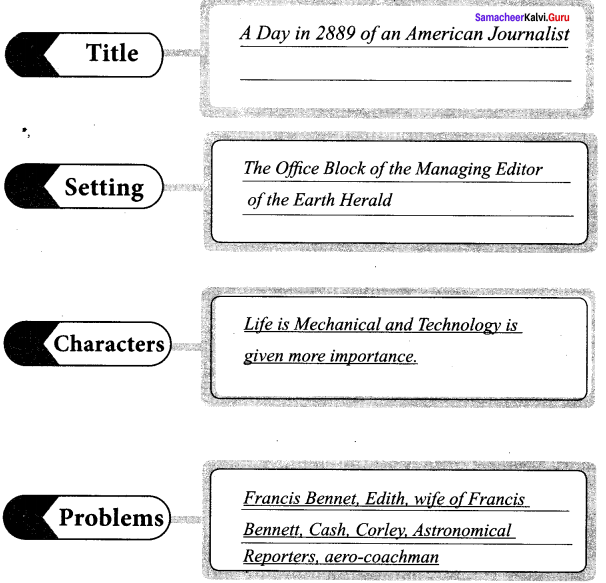

Additional:
A. Rearrange the following sentences in coherent order.
1. a. In this world of technological advancements newspapers are not printed but ‘spoken’.
b. Francis Bennett is the Managing Editor of the Earth Herald.
c. This story speaks about the people of the twenty-ninth century.
d. Earth Herald is the world’s largest newspaper.
e. The year is 2889, the date 25th July and the place is the office block.
Answers:
c, e, b, d, a
c. This story speaks about the people of the twenty-ninth century.
e. The year is 2889, the date 25th July and the place is the office block.
b. Francis Bennett is the Managing Editor of the Earth Herald.
d. Earth Herald is the world’s largest newspaper.
a. In this world of technological advancements newspapers are not printed but ‘spoken’.
2. a. As soon as he awoke, Francis Bennett switched on his phonotelephote.
b. Eight days ago his wife had been to France and he was feeling a little lonely.
c. Francis Bennett was in a bad temper.
d. The reason was the absence of his wife with him.
e. The wires of his Phonotelephote led to the house he owned in the Champs-Elysees.
Answers:
c, d, b, a, e
c. Francis Bennett was in a bad temper.
d. The reason was the absence of his wife with him.
b. Eight days ago his wife had been to France and he was feeling a little lonely.
a. As soon as he awoke, Francis Bennett switched on his phonotelephote.
e. The wires of his Phonotelephote led to the house he owned in the Champs-Elysees.
B. Fill in the blanks with the appropriate phrases given below to form a complete meaningful paragraph.
1. (by the electric current /to the house /could also be transmitted / completed by the telephote / As soon as)
(i) ………………… Francis Bennett woke up, he switched on his phonotelephote. The wires led (ii) ……………… he owned in the Champs-Elysees.The telephone, (iii) …………………….,is another of our time’s conquests! Though the transmission of speech (iv) …………………….. was already very old, it was only since yesterday that vision (v) ………………. was possible.
Answers:
(i) As soon as
(ii) to the house
(iii) completed by the telephote
(iv) by the electric current
(v) in the stellar world
2. (a series of taps /of his home in Paris / took his place/in spite of the distance/at the same time)
The table was laid and he (i) …………………. at it. Within reach of his hand was placed (ii) …………….. and before him was the curved surface of a phonotelephote, on which appeared the dining room (iii) …………….. Mr. and Mrs. Bennett had arranged to have lunch (iv) ……………….. nothing could be more pleasant than to be face to face (v) ……………….. to see one another and talk by means of the phonotelephotic apparatus.
Answers:
(i) took his place
(ii) a series of taps
(iii) of his home in Paris
(iv) at the same time
(v) in spite of the distance
C. Match the following appropriately:
1. 
Answers:
(i)(c), (ii)(e), (iii)(d), (iv)(a), (v)(b)
2. 
Answers:
(i)(b), (ii)(d), (iii)(e), (iv)(c), (v)(a)
D. Read the passage given below and answer the questions that follow:
1. That morning Francis Bennett awoke in rather a bad temper. This was eight days since his wife had been in France and he was feeling a little lonely. As soon as he awoke, Francis Bennett switched on his phonotelephote whose wires led to the house he owned in the Champs-Elysees. The telephone, completed by the telephote, is another of our time’s conquests! Though the transmission of speech by the electric current was already very old, it was only since yesterday that vision could also be transmitted.
A valuable discovery, and Francis Bennett was by no means the only one to bless its inventor when, in spite of the enormous distance between them, he saw his wife appear in the telephotic mirror. ‘Francis … dear FtancisL.’His name, spoken by that sweet voice, gave a happier turn to Francis Bennett’s mood. He quickly jumped out of bed and went into his mechanized dressing room.
(а) Why was Francis Bennett in a bad temper?
Answer:
Francis Bennett was feeling lonely as his wife had been to France eight days ago and so he was in a bad temper.
(b) What did he do as soon as he woke up?
Answer:
As soon as Francis woke up, he switched on the phonotelephote whose wires connected to his house in Champs Elysees where his wife was staying.
(c) What was the valuable discovery made just a day before 25th July?
Answer:
The valuable discovery was the telephotic mirror where Francis could see his wife appear on screen apart from hearing his voice.
(d) What changed the mood of Francis Bennett?
Answer:
When Francis heard his wife’s sweet voice say, ‘Francis…Francis’, his mood changed into a happy feel.
(e) What is considered a Time’s conquest?
Answer:
Telephone completed by telephote, resulting in phonotelephote is a Time’s conquest.
2. His name, spoken by that sweet voice, gave a happier turn to Francis Bennett’s mood. He quickly jumped out of bed and went into his mechanized dressing room.
Two minutes later, without needing the help of a valet, the machine deposited him, washed, shaved, shod, dressed and buttoned from top to toe, on the threshold of his office. The day’s work was going to begin. Francis Bennett went on into the reporters’ room.
His fifteen hundred reporters, placed before an equal number of telephones, were passing on to subscribers the news which had come in during the night from the four quarters of the earth. In addition to his telephone, each reporter has in front of him a series of commutators, which allow him to get into communication with this or that telephotic line. Thus the subscribers have not only the story but the sight of these events.
(a) What did Francis Bennett do when he became happy hearing wife’s sweet voice?
Answer:
As soon as Francis Bennett heard his wife’s voice he quickly jumped out of bed and went into his mechanized dressing room.
(b) What happened two minutes later?
Answer:
Two minutes later, without needing the help of a valet, the machine deposited Francis, washed, shaved, shod, dressed and buttoned him from top to toe, on the threshold of his office.
(c) How many reporters were there in the reporters’ room?
Answer:
There were about fifteen hundred reporters in the reporters’ room.
(d) What were the reporters doing when Francis entered the reporters’ room?
Answer:
The reporters were placed before an equal number of telephones and were passing on to subscribers the news which had come in during the night from the four quarters of the earth.
(e) What was the additional benefit that the subscribers were enjoying in recent times?
Answer:
In addition to a telephone, each reporter had in front of him a series of commutators, which allow him to get into communication with any onetelephotic line. Thus the subscribers had not only the story but the sight of all the events.
A Day in 2889 of an American Journalist by Jules Verne About the Author:
Jules Verne was bom in the city of Nantes, France on February 8th, 1828. His father was a lawyer, and at the beginning, Veme wanted to study law as well. When he was nineteen, – he started writing long pieces of literature, but his father wanted him to earn money as a lawyer, not as a writer. He decided to give up being a lawyer, and become a full-time professional writer instead. Veme married Aimee du Fraysse de Viane in January 1857 with his father’s blessing and continued to write until his death. On 24th of March 1905, Veme, who was sick with diabetes, died at his home in Amiens, France.
A Day in 2889 of an American Journalist Summary:
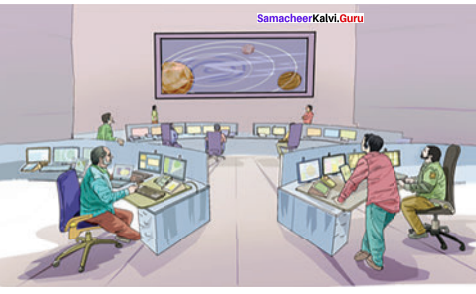
Introduction:
The author explains the life on earth after thousand years and that the daily activities of a normal human will be assisted by machines. For example the author envisions that travelling will be made easy. In this story the office block of the Earth Herald, the world’s largest newspaper, is illustrated during the year 2889.
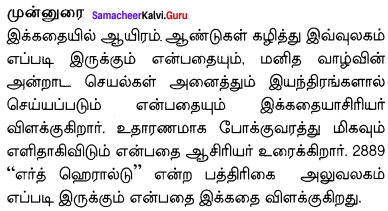
Francis Bennett and his office One early morning, Francis Bennett woke up bad tempered because his wife Edith had gone to Champs Elysees eight days ago. He switched on his phonotelephote whose wires led to the house he owned in the Champs-Elysees. The telephone, completed by the telephote, was another of their time’s conquests! From yesterday,vision could also be transmitted along with speech. Bennett blessed its inventor as he saw his wife appear in the telephotic mirror. Her voice and face changed his mood.
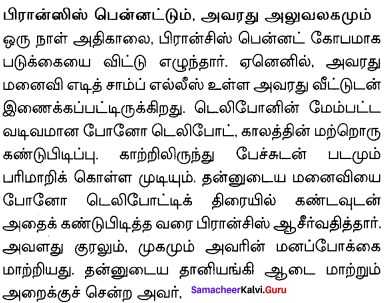
He went into his mechanized dressing room within two minutes, washed, shaved, shod, dressed and buttoned from top to toe, on the threshold of his office. The day’s work started at the reporters’ room. His fifteen hundred reporters, with their telephones, were speaking the news received from the four quarters of the earth to subscribers. Besides telephone, all reporters have commutators, which allow communication on telephotic line with visual sights.
Bennett questioned one of the ten astronomical reporters Cash about the recent discoveries in the stellar world. Cash replied that it was Phototelegrams from Mercury, Venus and Mars, and nothing from Jupiter since the Jovians signal could not be understood. He added that even results from the Moon wasn’t possible and one can’t blame optical science though moon was six hundred times nearer than Mars. Corley another reporter said it was the inhabitants which was refuted by Bennett who said the simplest way was to turn the moon round and find out.
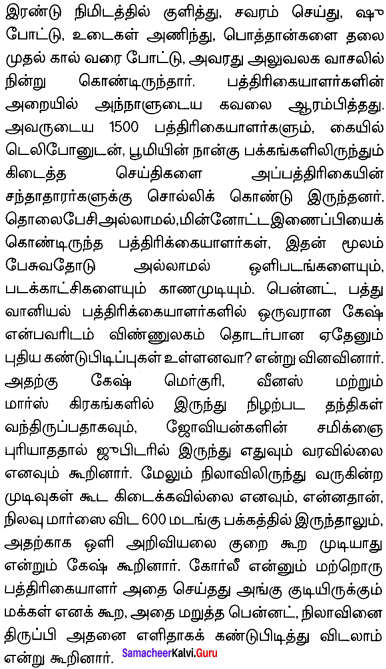
Bennett’s scientific lab
From then on, the scientists of the Bennett factory started working on turning satellite. One of the Earth Herald’s astronomers had just determined the elements of the new planet Gandini and Bennett was delighted at his accuracy. He wanted the reporters to pass on the news to the subscribers immediately. The broad gallery for such a journal as the Earth Herald brought in an average of three million dollars daily.
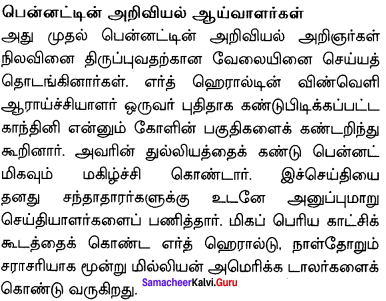
Luxury life of Bennett
When the clock struck twelve, the director of the Earth Herald sat in a rolling armchair and reached his dining room half a mile away. The table was laid before him and in front of him was the phonotelephote. The couple had arranged to have lunch at the same time, see and talk by phonotelephote. Francis Bennett was one of the subscribers to the expensive, Society for Supplying Food to the Home with thousand varieties through pneumatic tubes. He was finishing his coffee in solitude when Mrs. Bennett appeared in the telephote screen after work.
He then sped past to his accumulator works at Niagara by the aero-car at a speed of about four hundred miles an hour. Below him were the towns with moving pavements which carry the wayfarers along the streets. He returned, by way of Philadelphia, Boston and New York, to Centropolis, where his aero-car put him down about five o’clock. The waiting- room of the Earth Herald was crowded awaiting Bennett to return.
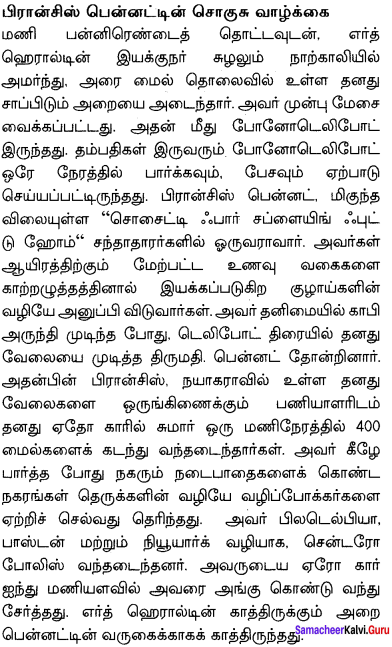
New Researches of Bennet
He chose carefully among the different proposals. The best was a young man whose broad brow indicated intelligence. He told Bennett about the elements estimated at seventy five now reduced to three to which Bennett told him that it would reduce to one in three weeks if he had money. He knew for sure that he would have discovered absolute, and the resultant, a human-being without a soul was confirmed by Bennett. The young fellow was assigned to the scientific editorial department of Bennett’s journal.
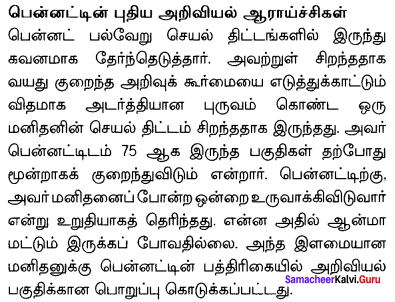
A second inventor, had the idea of moving a whole city in a single block. As a demonstration, the town of Saaf, situated fifteen miles from the sea would be transformed into a seaside resort. Francis Bennett, attracted by this project, agreed to take a half-share in it. Francis Bennett sat in an easy-chair in the audition-room to hear the proposal. Pressing a button, he communicated with the Central Concert. Re was charmed on a series of delicious harmonico-algebraic formulae.
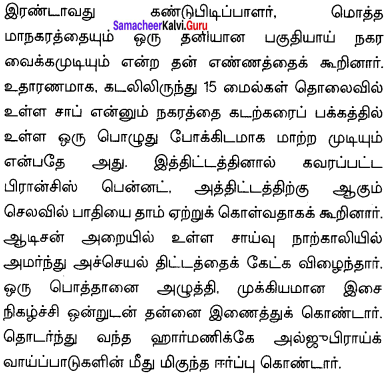
Time for family
During his meal, phonotelephotic communication was tuned to speak to Edith. Edith told him that she was leaving to Centropolis the very moment by tube. He confirmed her arrival at Centropolis at 11:59 p.m. according to Centropolis time. These submarine tubes, travels from Paris in two hundred and ninety-five minutes than the aero-trains travelling at six hundred miles an hour. Francis Bennett, felt tired and went for a bath before going to bed. He touched the button and got ready for bath.
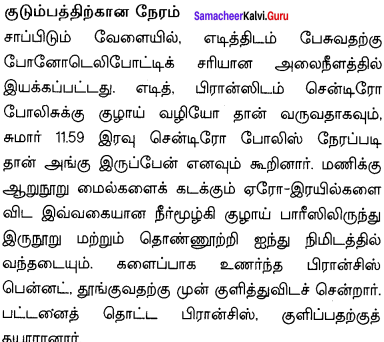
Conclusion:
This story brings out the fact that as long as humans aspire and work hard, there will be developments and innovations in this world. Smoke-free vehicles and machines that would instantly do what you desire will come forth. Therefore humans will achieve maximum heights in the field of Science and Technology.
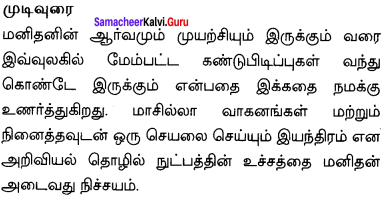
A Day in 2889 of an American Journalist Glossary:
Textual:
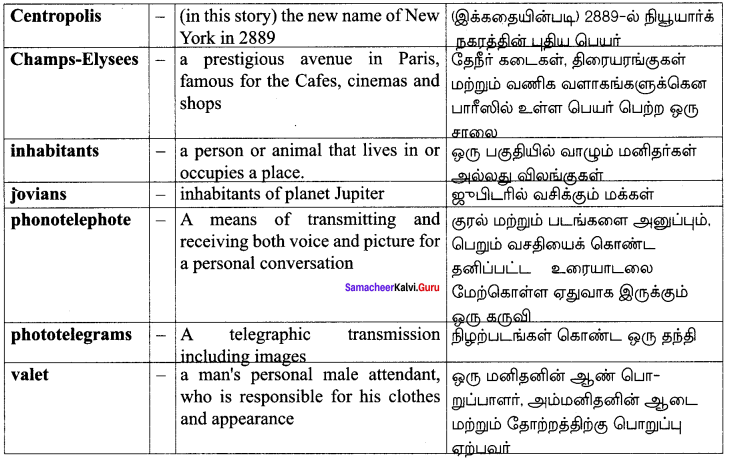
Additional:
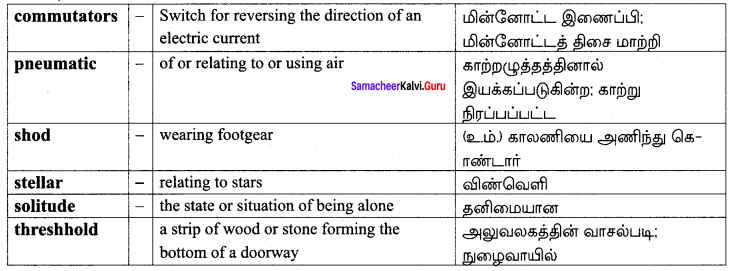
We hope the data given here will benefit you to the fullest extent at the time of preparation. For better understanding of English subject this Samacheer Kalvi 10th English Solutions for Class 10th English Supplementary Chapter 5 A Day in 2889 of an American Journalist PDF is the best resource. Download & ace up your preparation. Keep in touch with us and get the latest information on Tamilnadu State board Textbook Solutions PDF.